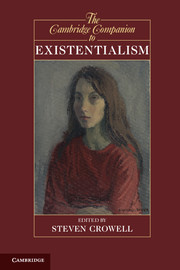Book contents
- Frontmatter
- I Introduction
- II Existentialism in Historical Perspective
- III Major Existentialist Philosophers
- 4 Kierkegaard’s single individual and the point of indirect communication
- 5 “What a monster then is man”: Pascal and Kierkegaard on being a contradictory self and what to do about it
- 6 Nietzsche: after the death of God
- 7 Nietzsche: selfhood, creativity, and philosophy
- 8 Heidegger: the existential analytic of Dasein
- 9 The antinomy of being: Heidegger’s critique of humanism
- 10 Sartre’s existentialism and the nature of consciousness
- 11 Political existentialism: the career of Sartre’s political thought
- 12 Simone de Beauvoir’s existentialism: freedom and ambiguity in the human world
- 13 Merleau-Ponty on body, flesh, and visibility
- IV The Reach of Existential Philosophy
- Bibliography
- Index
- OTHER VOLUMES IN THE SERIES OF CAMBRIDGE COMPANIONS
4 - Kierkegaard’s single individual and the point of indirect communication
from III - Major Existentialist Philosophers
Published online by Cambridge University Press: 28 March 2012
- Frontmatter
- I Introduction
- II Existentialism in Historical Perspective
- III Major Existentialist Philosophers
- 4 Kierkegaard’s single individual and the point of indirect communication
- 5 “What a monster then is man”: Pascal and Kierkegaard on being a contradictory self and what to do about it
- 6 Nietzsche: after the death of God
- 7 Nietzsche: selfhood, creativity, and philosophy
- 8 Heidegger: the existential analytic of Dasein
- 9 The antinomy of being: Heidegger’s critique of humanism
- 10 Sartre’s existentialism and the nature of consciousness
- 11 Political existentialism: the career of Sartre’s political thought
- 12 Simone de Beauvoir’s existentialism: freedom and ambiguity in the human world
- 13 Merleau-Ponty on body, flesh, and visibility
- IV The Reach of Existential Philosophy
- Bibliography
- Index
- OTHER VOLUMES IN THE SERIES OF CAMBRIDGE COMPANIONS
Summary
THE SINGLE INDIVIDUAL
Kierkegaard once wrote that any historical importance attached to his writings would derive from his “category of the single individual.” Many will acknowledge the cultural debt to Kierkegaard in just those terms. Yet his category is a special one, and those apprised of its features may prefer to talk of Kierkegaard's example rather than his legacy. Others may even regret that Kierkegaard's category might seem to mark the road back toward Augustinian theology rather than onward, say, to Karl Barth and Paul Tillich. But the spaces among whose coordinates Kierkegaard's cultural position can be plotted are diverse. So much so that any account that draws on just one of them runs the risk not only of overhasty dismissal but of failure to penetrate the rich existential core of Kierkegaard's thinking, not least in its religious respect.
In claiming the category as “his,” Kierkegaard meant it was his own discovery. More than that, he had discovered it in a way other than that in which a zoologist might discover a new species, that is, by collecting and comparing evidence. Nor was it in the way that a mathematician or a philosopher might find a place for a new category in a deductive system. Kierkegaard's discovery was “his” in the special sense that it was the fruit of his own personal experience.
- Type
- Chapter
- Information
- The Cambridge Companion to Existentialism , pp. 71 - 95Publisher: Cambridge University PressPrint publication year: 2012
- 1
- Cited by

